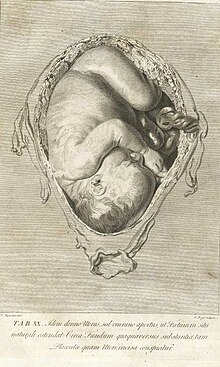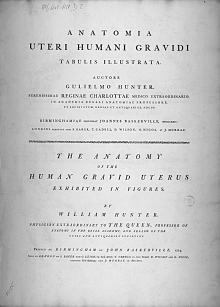William Hunter (anatomist)
William Hunter (born May 23, 1718 in East Kilbride , South Lanarkshire , † March 30, 1783 in London ) was a Scottish anatomist and obstetrician .
Live and act
William Hunter was born on Long Calderwood Farm in East Kilbride, a few miles south of Glasgow. His parents were the farmer John Hunter († 1741) senior and Agnes Hunter, nee Paul. William Hunter was the older brother of surgeon John Hunter (1728-1793). They had eight other siblings.
William first attended the College of Glasgow and then began to study theology at the University of Glasgow in 1731 , but then switched to medicine in 1737 to work as an assistant in his practice in Hamilton for three years under William Cullen , whom he had already met in Glasgow to improve one's knowledge. In the following time he heard in Edinburgh anatomy lectures (anatomical lectures) with Alexander Monro I (1697-1767), the founder of the Edinburgh Medical School in Edinburgh.
In 1741 Hunter went to London , initially as an intern to the obstetrician William Smellie , where he also gave private lessons to the son of his other teacher, James Douglas . He traveled to Paris with James Douglas' son to listen to Antoine Ferrein's anatomy lectures . and heard lectures from Samuel Johnson (1709–1784). He also began training in anatomy at St George's Hospital in London.
From 1746 he himself held medical lectures and successfully ran a private anatomy school in Covent Garden (London). He was supported during this time by his brother John Hunter, with whom he had then, however, disagreed because of a dispute over priorities regarding the prenatal blood circulation. He also toured Holland and France and on October 24, 1750, he received an MD from Glasgow University. After that he went to London, settled in London as a doctor, but soon devoted himself exclusively to obstetrics and anatomical studies. In 1764 he became the doctor of Sophie Charlotte von Mecklenburg-Strelitz , the wife of King George III. He was appointed a member of the Royal Society in 1767 and Professor of Anatomy, Professor of Anatomy at the Royal Academy in 1768. In his function as professor of anatomy, he built an anatomical theater in Haymarket for his lectures with a museum. In 1782 he became a foreign member of the Académie des Sciences in Paris.
Hunter also performed corpse conservation services . A procedure in which the corpse, in addition to dissection and disinfecting surface treatment, was also preserved from the inside by injecting preservative substances into the bloodstream , mostly through the carotid artery , was described by William Hunter and first used in practice in 1775 by his brother John applied.
Hunter was a great collector, especially of ancient coins and books. His collections are now in the University of Glasgow's Hunterian Museum and Art Gallery , University of Glasgow. In order to have a curator for the collection, Georg III. 1807 the Regius Chair of Natural History at the University of Glasgow . In addition to managing the museum, the professors taught geology and zoology until the chair was renamed the Regius Chair of Zoology in 1902 and the professors concentrated on these.
Fonts (selection)
- The history of an aneurysm of the aorta, with some remarks on aneurysms in general. In: Medical Observations and Inquiries. Volume 1, 1757, pp. 323-357.
- Medical commentaries . 2 volumes. London 1762.
- Anatomy of the human gravid uterus . London 1775.
- Three cases of mal-conformation of the heart. In: Medical Observations and Inquiries. Volume 6, (London) 1784, pp. 291-309.
literature
- George Thomas Bettany : Hunter, William (1718–1783) . In: Sidney Lee (Ed.): Dictionary of National Biography . Volume 28: Howard - Inglethorpe. , MacMillan & Co, Smith, Elder & Co., New York City / London 1891, pp. 302 - 305 (English).
- Barbara I. Tshisuaka: Hunter, William. In: Werner E. Gerabek , Bernhard D. Haage, Gundolf Keil , Wolfgang Wegner (eds.): Enzyklopädie Medizingeschichte. De Gruyter, Berlin / New York 2005, ISBN 3-11-015714-4 , p. 645.
Individual evidence
- ↑ Biography William Hunter ( Memento of February 8, 2012 in the Internet Archive ) (English)
- ^ A b c Barbara I. Tshisuaka: Hunter, William. In: Encyclopedia of Medical History. 2005, p. 645.
- ^ List of members since 1666: Letter H. Académie des sciences, accessed on November 28, 2019 (French).
- ↑ Tom Hickman, Death - A User's Guide, London 2002, pp. 100-101.
- ↑ a b unknown: Veterinary, Medical and Life Sciences. Zoology. In: University of Glasgow website. University of Glasgow, accessed December 31, 2018 .
| personal data | |
|---|---|
| SURNAME | Hunter, William |
| BRIEF DESCRIPTION | Scottish anatomist and obstetrician as well as art collector |
| DATE OF BIRTH | May 23, 1718 |
| PLACE OF BIRTH | East Kilbride , South Lanarkshire |
| DATE OF DEATH | March 30, 1783 |
| Place of death | London |


